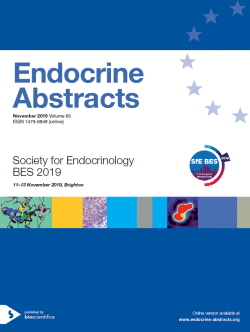
Society for Endocrinology BES 2019
Brighton,
United Kingdom
11 Nov 2019 - 13 Nov 2019

ORAL COMMUNICATIONS
Thyroid
ea0065oc4.1 | Thyroid | SFEBES2019
A high-throughput yellow fluorescent protein (YFP) cell-based screen identifies autophagy modulators to increase the effectiveness of radioiodine therapy
Read Martin , Baker Katie , Fletcher Alice , Thornton Caitlin , Alshahrani Mohammed , Nieto Hannah , Khan Rashida , Webster Jamie , Haggie Peter , Verkman Alan , Alderwick Luke , Boelaert Kristien , Smith Vicki , McCabe Christopher
ea0065oc4.2 | Thyroid | SFEBES2019
Reduced Length of Hospital Stay with the use of recombinant TSH compared to Thyroid Hormone Withdrawal –A two centre retrospective study
Jeeyavudeen MohammadSadiq , Johnson Elinor , Graveling Alex , McKiddie Fergus , Duguid Rebecca , Cluny Laura , Bassett-Smith Victoria , Gibb Fraser , Strachan Mark , Abraham Prakash
ea0065oc4.3 | Thyroid | SFEBES2019
The disturbed thyroid gland homeostasis in conditions of subacute exposure to thyroid-disrupting chemicals: experimental study in Wistar rats
Buha Aleksandra , Curcic Marijana , Milovanovic Vesna , Bulat Zorica , Antonijevic Biljana
ea0065oc4.4 | Thyroid | SFEBES2019
Development of auto-immune thyroid dysfunction in multiple sclerosis patients receiving Alemtuzumab is associated with improved response to treatment
Sovetkina Alina , Nicholas Richard , Malik Omar , Tona Francesca , Dorsey Rachel , Scalfari Antonio , Rigoni Eleonora , Nandoskar Ashwini , Singh-Curry Victoria , Martin Niamh
ea0065oc4.5 | Thyroid | SFEBES2019
The prevalence of thyroid dysfunction and autoimmunity in women with history of miscarriage or subfertility across the United Kingdom
Dhillon-Smith Rima , Tobias Aurelio , Smith Paul , Chan Shiao , Boelaert Kristien , Coomarasamy Arri
ea0065oc4.6 | Thyroid | SFEBES2019
Driver events in thyroid cancer recurrence
Nieto Hannah , Thornton Caitlin , Fletcher Alice , Menezes Albert Nobre de , Brookes Katie , Alshahrani Mohammed , Read Martin , Boelaert Kristien , Smith Vicki , Cazier Jean-Baptiste , Mehanna Hisham , McCabe Chris



